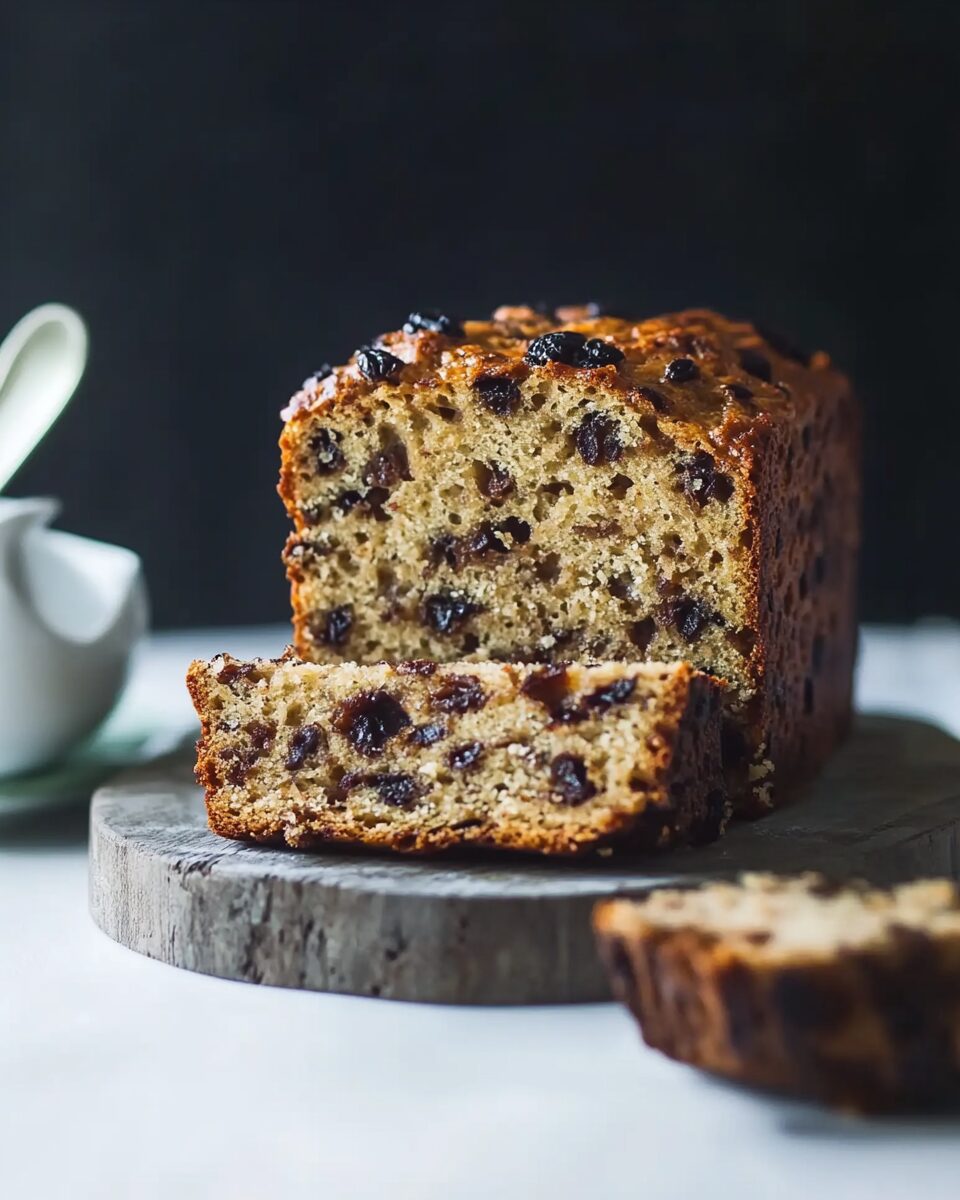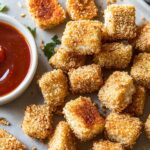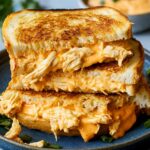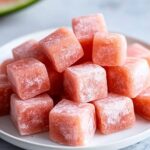Traditional Irish Barmbrack is a beloved Baking recipe in Irish households, particularly enjoyed around Halloween but also perfect for tea time year-round. This sweet, fruit-filled bread is made with tea-soaked dried fruit, giving it a wonderfully moist texture and rich flavor. It’s best served sliced and spread with butter, alongside a warm cup of tea.
Full Recipe:
Ingredients
- 225g (about 1 ¾ cups) self-raising flour
- 350g (about 2 cups) mixed dried fruit (sultanas, raisins, currants)
- 250ml (1 cup) cold tea
- 125g (about ½ cup) brown sugar
- 1 large egg
- 1 teaspoon mixed spice (or a blend of cinnamon, nutmeg, and allspice)
Directions
- Place the dried fruit in a bowl and pour over the cold tea. Let the fruit soak overnight.
- Preheat oven to 170°C (340°F). Grease and line a loaf tin with parchment paper.
- Stir the brown sugar, egg, and mixed spice into the soaked fruit.
- Gradually sift in the self-raising flour, folding gently until fully combined.
- Transfer the batter into the prepared loaf tin and smooth the top.
- Bake for approximately 1 hour or until a skewer inserted into the center comes out clean.
- Allow the barmbrack to cool in the tin for 10 minutes, then transfer to a wire rack to cool completely.
- Slice and serve with butter and a cup of tea for the perfect Irish treat.
Nutrients
- Calories: Approximately 220 per slice
- Carbohydrates: 50g
- Protein: 4g
- Fat: 1g
- Fiber: 3g
- Sugar: 25g
The History and Cultural Significance of Barmbrack
Barmbrack has deep roots in Irish history, dating back centuries as a traditional bread made for special occasions. The name itself comes from the Irish word “bairín breac,” meaning “speckled loaf,” a reference to the dots of dried fruit scattered throughout the bread. Traditionally, barmbrack was associated with Samhain, the ancient Celtic festival that eventually became modern-day Halloween.
In Irish households, barmbrack was not just a treat—it was part of a fortune-telling tradition. Small symbolic items were baked into the bread, each with its own meaning. A coin signified wealth, a ring foretold marriage, and a piece of cloth symbolized bad luck or poverty. Families would gather around the table, eagerly cutting slices to discover their fortunes for the coming year.
What Makes Barmbrack Unique
What sets barmbrack apart from other fruit breads is the method of soaking the dried fruit in tea. This technique not only plumps up the fruit, making it tender and juicy, but also infuses the bread with a subtle tea flavor that enhances the overall taste. The gentle spice blend adds warmth, making it a perfect bread for autumn and winter.
Barmbrack sits somewhere between a cake and a bread, with its tender crumb and fruity sweetness, but without being overly rich or sugary. This balance makes it a versatile recipe that can be enjoyed at breakfast, afternoon tea, or even as a dessert.
A Staple at Irish Tea Time
No Irish tea table is complete without barmbrack. Served thickly sliced with butter, it is a comforting, homely treat that brings a sense of tradition and nostalgia. In Ireland, tea is more than just a drink—it’s a daily ritual, a moment of pause, and a symbol of hospitality. Pairing tea with barmbrack enhances the experience, as the tea echoes the flavors infused in the bread itself.
Simple Ingredients with Maximum Flavor
One of the best things about barmbrack is that it requires only a handful of ingredients, many of which are pantry staples. Flour, dried fruit, sugar, tea, and spices come together in perfect harmony. This simplicity, combined with the bold flavors created by the soaking process, is what makes barmbrack so appealing to home bakers.
The Importance of the Tea Soak
The overnight tea soak is the secret to great barmbrack. This step allows the dried fruit to fully absorb the liquid, softening it and infusing it with deep flavor. Traditional Irish breakfast tea is often used, but other strong black teas work just as well. Some variations even use spiced tea or add a splash of whiskey to the soak for an extra layer of flavor.
This soaking process ensures that every bite of barmbrack is bursting with juicy fruit, preventing the bread from being dry or crumbly. It’s this moisture that makes barmbrack stand out from other fruit loaves.
A Recipe Passed Down Through Generations
In many Irish families, barmbrack recipes are passed down from grandparents to grandchildren, each generation adding its own personal touch. Some families prefer to add extra spices, others like to throw in a handful of chopped nuts, and some even soak the fruit in whiskey instead of tea for a richer twist. This adaptability is part of what keeps barmbrack so beloved—it can be tailored to suit every taste while still maintaining its traditional roots.
Seasonal Celebrations and Everyday Enjoyment
While Halloween is the time most closely linked with barmbrack, it is far too delicious to reserve for just one night of the year. Many bakeries across Ireland sell barmbrack year-round, and home bakers regularly whip up loaves for family gatherings, weekend treats, or holiday celebrations. It’s just as welcome on a Christmas table as it is at a summer picnic, proving its versatility and timeless appeal.
Health Benefits and Nutritional Value
Although barmbrack is a sweet treat, it does offer some nutritional benefits thanks to its generous amount of dried fruit. Sultanas, raisins, and currants are all rich in fiber, antioxidants, and essential vitamins such as iron and potassium. When paired with whole grain flour or reduced sugar, barmbrack can even become a relatively wholesome option compared to more heavily frosted cakes or rich pastries.
Additionally, the lack of butter or oil in the batter itself keeps the fat content low, making this a lighter indulgence. However, many argue that barmbrack’s true joy lies in spreading a thick layer of Irish butter on each slice, adding creamy richness to every bite.
A Versatile Base for Creative Twists
While traditional barmbrack is made with a specific mix of dried fruit and spices, the recipe can easily be adapted to include different flavors. Some modern variations add citrus zest for a bright twist, while others incorporate chopped apples, dates, or even chocolate chips for a more indulgent take. Spices like ginger or cardamom can also be added to complement the fruit.
For those looking for a more festive version, some bakers glaze the top of the loaf with honey or apricot jam for a glossy finish, or sprinkle it with a dusting of powdered sugar. These small tweaks allow home bakers to put their own personal spin on this timeless bread.
The Perfect Gift from the Kitchen
Homemade barmbrack also makes a thoughtful gift, particularly during holidays. Wrapped in parchment paper and tied with twine, a freshly baked loaf feels rustic and heartfelt—an edible piece of Irish tradition to share with friends and family.
A Symbol of Irish Hospitality
At its heart, barmbrack is a symbol of the warm hospitality that Irish culture is famous for. Offering guests a slice of barmbrack with a cup of strong tea is a gesture of welcome and comfort. This sense of connection, tradition, and generosity is what makes barmbrack more than just a recipe—it’s a part of Ireland’s soul.
Conclusion
Traditional Irish Barmbrack is much more than a simple fruit bread. It’s a reflection of Ireland’s rich culinary heritage, its love of tea, and its spirit of hospitality. Whether enjoyed at Halloween as part of an ancient fortune-telling tradition or served year-round as a comforting tea-time treat, barmbrack has earned its place as a beloved symbol of Irish home baking. Its simplicity, adaptability, and deep connection to history make it a recipe worth preserving and passing down. With its tender crumb, juicy fruit, and gentle warmth from spices, barmbrack offers a taste of Ireland’s past and present in every slice—a truly timeless treasure.






